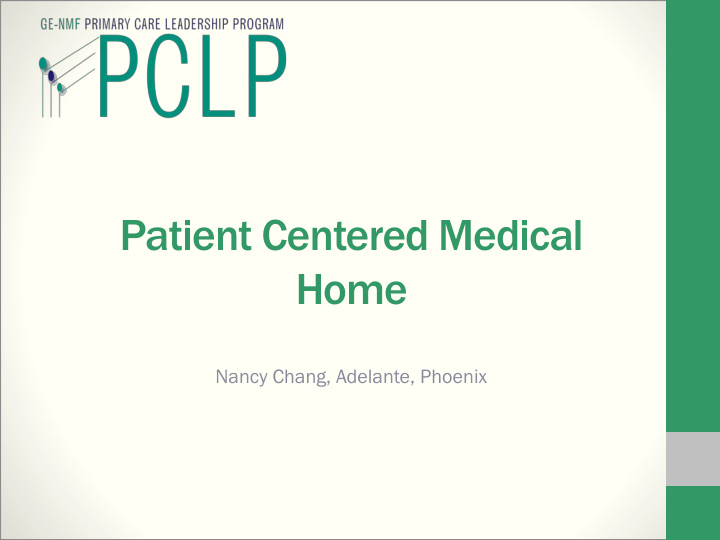



Patient Centered Medical Home Nancy Chang, Adelante, Phoenix
Introduction • US healthcare system is broken • Medical care is very expensive, but poor in quality and delivery • Patient Centered Medical Home (PCMH) was proposed in 1967 by the American Academy of Pediatrics • Purpose of PCMH is to establish a central place for patients to receive care and to improve care coordination
PCMH Definition • 1) Patient Centered- partnership among practitioners, patients and their families • 2) Comprehensive- team to care for patient’s physical and mental health, including preventative care, chronic care, and acute care • 3) Coordinated care- organize elements of all health care, ex: specialty care, home health, hospital • 4) Accessible: electronic and telephone access • 5) Quality: use IT tools to assist in providing care (ex: reminders)
Examples • Hudson River Health Care • Patient Care Partners (community health workers) • Coordinate care, make referrals, respond to patient needs, f/u phone calls to patients, check to ensure referral appointment was completed • Nurses (RN) • Bilingual nurse to manage those at highest risk, provide education • Electronic Health Records (EHR) • Prompts preventive care and DM specific interventions • Washington State Dept. of Health • Medical Assistants (MA)- improve care flow, handle group visits, care coordination • RN’s - Dedicated to managing high risk patients • Group sessions to provide support and learn about cholesterol, blood sugar, etc. • Use EHR to identify high risk patients
Examples cont … • Thomas Jefferson University • “Super” Licensed Practical Nurse (LPN) and “Super” MAs • Use data to monitor, coordinate care, identify DM patients, identify patients not meeting targets, make f/u phone calls to patients, streamline referrals to dietician, podiatrist, and preventive care • Pharmacist • Visits site to discuss HbA1c, cholesterol, meds, etc. • Weslaco Medical Clinic • Shared medical appointments: 90 minutes DM class, patients pulled individually to see provider over this time period, class covers insulin, BP, DM related topics • EHR- Used to keep track of screenings and other tasks (ex: labs)
Examples cont … • Children with Special Health Care Needs (CSHCN) • Randomized controlled intervention • Care coordinator/family support specialist is a paid parent with experience caring for CSHCN, provides emotional support, home visits, info, advocacy, monthly follow up • Lead nurse practitioner provides core intervention, education • Study results: improved outcomes, suggests financial savings but does not elaborate • Autism Primary Care Medical Home Intervention • General pediatrician • Nurse care coordinator • Scheduling coordinator • Specific care plan, monitoring log, coordination with outside sources
• Analyze findings, questions raised, further research • 31 peer reviewed studies rated as good or fair • No single strategy used in most studies • Improvement in preventive services and patient experience • Suggests possible reduction in ER visits • Insufficient evidence to evaluate efficacy for chronic illness • Insufficient evidence to determine efficacy of PCMH on clinical outcomes and costs
Challenges to studying PCMH • Studies vary widely in range of outcome • Lack of consistency in studies • Inconsistent use definitions for PCMH • Quality of studies • Measuring outcomes
Conclusions • Not enough long term data available to evaluate costs and clinical outcomes • Need models that are adaptable to other chronic illnesses and high risk populations • No standard way to deliver PCMH care • Opportunity to create new standards • Best strategy to establish PCMH is to target the specific patient population with the resources available
References • Defining the Medical Home | Patient-Centered Primary Care Collaborative . (n.d.). Retrieved July 22, 2013, from http://www.pcpcc.org/about/medical-home • Farmer, J. E., Clark, M. J., Drewel, E. H., Swenson, T. M., & Ge, B. (2011). Consultative care coordination through the medical home for CSHCN: a randomized controlled trial. Maternal and child health journal , 15 (7), 1110 – 8. doi:10.1007/s10995-010-0658-8 • Golnik, A., Scal, P., Wey, A., & Gaillard, P. (2012). Autism-specific primary care medical home intervention. Journal of autism and developmental disorders , 42 (6), 1087 – 93. doi:10.1007/s10803-011-1351-5 • Helfgott, A. W. (2012). The patient-centered medical home and accountable care organizations: an overview. Current opinion in obstetrics & gynecology , 24 (6), 458 – 64. doi:10.1097/GCO.0b013e32835998ae • Jackson, G. L., Powers, B. J., Chatterjee, R., Bettger, J. P., Kemper, A. R., Hasselblad, V., Dolor, R. J., & Williams, J. W. (2012). The Patient-Centered Medical Home: A Systematic Review. Ann Intern Med , 158 (3), 169-178. • Longworth, D. L. (2011). Accountable care organizations, the patient-centered medical home, and health care reform: what does it all mean? Cleveland Clinic journal of medicine , 78 (9), 571 – 82. doi:10.3949/ccjm.78gr.11003 • Patient-Centered Primary Care Collaborative (2011). Practices in the Spotlight: The medical home and diabetes care. www.pcpcc.net
Recommend
More recommend